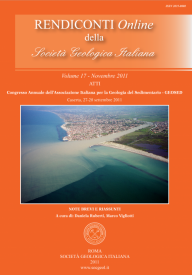
Tecniche di terreno e di laboratorio per la riproduzione di tracce fossili
Caruso C. (*) & Sonnino M. (*)
(*) Dipartimento di Scienze della Terra, Università degli Studi della Calabria, 87036 Arcavacata di Rende (CS), Italy. E-mail: claudia.caruso@unical.it; m.sonnino@unical.it
Volume: 17/2011
Pages: 47-52
Abstract
Field and laboratory techniques to reproduce trace fossils.
Field and laboratory techniques for the reproduction of trace fossils are described. In fact, studying trace fossils sometimes becomes necessary to produce an image or a copy of the track itself, regardless of photographic reproduction. Copy can be reproduced in the laboratory, but sometimes this work must be carried out directly in the field.
Two techniques applied in the fi eld are here analyzed: (i) handdrawing, that consists in tracing the morphology of the ichnofossils on a transparent sheet, using different colours to group the diverse type of trace fossils; (ii) use of two different kinds of silicon rubber, to create a negative of trace fossils. This last technique, long used to reproduce faithful casts of body fossils in the laboratory, has been applied here for the fi rst time in the fi eld (at least in Italy) to replicate trace fossils of marine invertebrates.
In the laboratory the laser scanning technique has been used to capture 3D-images of trace fossils, in order to highlight details that are unreadable using only the camera, and then to create a database of 3D-images about the traces of marine invertebrates.
Keywords
Get Full Text